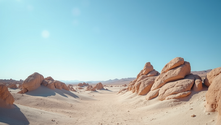top of page
News


The Role of Izaña-2 in Ensuring a Safer Orbital Environment for Satellites
As the threat from space debris becomes a daily concern for satellite operators, the European Space Agency is developing innovative technologies to keep our orbits safe. At the Izaña station in Spain, ESA's Izaña-1 and Izaña-2 laser-ranging stations are testing a high-precision method to track debris, prevent collisions, and eventually, even nudge junk out of the way.
Aug 281 min read


TESS Telescope Reveals Interstellar Comet 3I/ATLAS Before Official Discovery
When an object from another star system visits ours, astronomers race to learn its secrets. But sometimes, the first clues are found not by looking forward, but by looking back. A new study reveals that the Transiting Exoplanet Survey Satellite (TESS)—a telescope designed to find planets around other stars—had captured images of our newest interstellar visitor, 3I/ATLAS, as far back as May 2025. Unearthing this "pre-discovery" data required a clever technique to find a faint,
Aug 281 min read


The Beauty of Atmospheric Effects on Exoplanets and Their Implications
From strange bright lights flanking the sun to rainbow-like halos seen from an airplane, Earth's atmosphere creates a stunning variety of optical displays. These phenomena are more than just beautiful—they are scientific clues, telling us about the properties of atmospheric particles. A recent paper suggests we can use this same science to decode the atmospheres of planets far beyond our solar system.
Aug 281 min read


Can Oceans Exist Around Dying Stars? A Look at White Dwarfs
When our sun runs out of fuel, it will swell into a red giant before collapsing into a tiny, dense white dwarf. This cataclysm is often seen as the end of our solar system, but it may actually be the beginning of a new phase of life. Astronomers are now seriously considering whether planets orbiting these stellar remnants could retain their oceans and support life, potentially making the galaxy's 10 billion white dwarfs promising targets in the search for extraterrestrial bio
Aug 281 min read


How a Catastrophic Collision Gave Earth the Gift of Life
Earth is a vibrant, water-rich world, but it didn't start that way. Formed in the hot, inner solar system, the early proto-Earth was a dry, rocky planet, devoid of the volatile elements essential for life. So how did it become the habitable oasis we know today? A new study reveals that our planet's chemical makeup was set surprisingly fast, and that its life-giving properties are likely thanks to a later, cataclysmic event.
Aug 281 min read


How Crater Counting Reveals the Moon's Geological Timeline
The Moon is thought to have formed from a homogenous magma ocean, yet its two sides are drastically different. Toggle between the two faces to see the dichotomy.
Aug 261 min read


How Apollo Missions Revealed the Moon's Mysterious Beginnings
You know, if you think about it, and trust me we're about to, the moon is kind of weird. Of all the terrestrial worlds of the solar system, we're the only one with a substantial natural satellite. Mercury and Venus have nothing. And while Mars technically has two moons, they're really just captured asteroids and don't really count. Sorry Phobos and Deimos, but that's the way it is.
Aug 261 min read


How Thermoelectric Generators Could Transform Lunar Energy Needs
As NASA's Artemis program aims to establish a long-term human presence on the Moon, one of the greatest challenges is finding a reliable power source. A recent study from the Republic of Korea explores how Thermoelectric Generators (TEGs) could be uniquely suited to the task, not just by surviving the Moon's harsh conditions, but by harnessing them.
Aug 261 min read


What Makes Up the Moon? Insights from Modern Scientific Analysis
A set of instruments shut off in 1978 are still producing useful results: the seismometers left by the Apollo missions. At first, they proved the Moon has "moonquakes." Decades later, as our analysis techniques improved, we squeezed more information from that same old data. By tracking how vibrations travel through the Moon, we finally found definitive evidence of its core.
Aug 261 min read


The Mysterious Journey of Interstellar Visitors: Tracing the Paths of ‘Oumuamua, Borisov, and ATLAS
New research maps the galactic origins of 1I/'Oumuamua, 2I/Borisov, and 3I/ATLAS, revealing they are a diverse group of visitors from across the Milky Way. Unlike planets, these objects are not bound by our sun's gravity. They follow hyperbolic paths, swinging by our star at high speed before heading back out into interstellar space.
Aug 191 min read


How Mercury's Surface Has Changed Over Billions of Years
Since it formed 4.5 billion years ago, Mercury has been continuously losing heat. Like a fresh-baked cookie, this cooling causes it to contract. As the rocky surface shrinks, it cracks, creating "thrust faults" that scar the planet. By measuring these faults, scientists can estimate the total shrinkage, but prior estimates have varied wildly, suggesting Mercury's radius has shrunk by anywhere from 1 to 7 kilometers.
Aug 131 min read


Chiron: The Hybrid Object Redefining Our View of the Cosmos
You've seen the phrase on social media. As a professional astronomer, I'd never heard of it. So... what is Chiron, and what does it *really* mean for it to be in retrograde?
First, it's pronounced "Kai-ruhn" (with a hard K). Discovered in 1977, it's a "Centaur" orbiting between Jupiter and Neptune. It's not just an asteroid; it's a cosmic oddball.
Aug 91 min read
bottom of page


